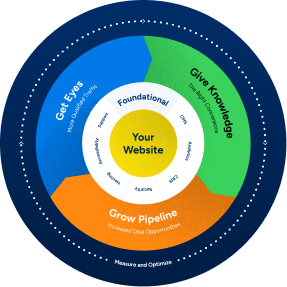Building a B2B website is not just a once-off thing and for a business that is serious about growth, regular optimization is crucial. Imagine if Facebook’s creators built the social media platform but never touched it again to make improvements. It would not have become the gigantic business that it is today.
As such, regular B2B optimizing website planning is essential. No website can ever be completely perfect or flawless, but yours can come very close through consistent optimization.
If you let your B2B website sit idly and never check its performance and make changes, you won’t reap the kind of rewards that you should get from a good website.
So, how do you optimize your website? Let’s find out!
Determine Your B2B Website’s Current State
The first step towards optimization is getting a clear understanding of your website’s current condition. You need to scrutinize every page and determine its performance. That way, you can easily identify the areas that need attention and the pages that are actually doing good.
Knowing the elements that need to be changed will also make it easier to come up with ideas to improve your website in general. It might not be necessary to give the entire website an overhaul for improved optimization, just parts of it.
You can even learn from the well-performing pages what kind of content and strategies work best and which ones to avoid.
Test Existing Lead Generators
The next step to optimizing your website is identifying and evaluating your best lead degeneration sources. For example, one of your landing pages could get a lot of visitors but fails at converting them. Another page could get low traffic but perform better at conversions.
Use an online tool like Website Grader to help you find out more about the performance of your pages and the elements having the biggest impacts. Your CTA (Call To Action) buttons or a specific kind of content could be amazing without you realizing it.
Learn from the data that you gather here and find the lead generators doing the most for your website. Use what you’ve learned to optimize your website in the future.
Optimize Site Architecture
Your website architecture forms the foundation of everything on your site. It’s important that the architecture is planned to improve the user experience so that visitors can navigate through your pages with ease.
The way information is structured can also improve your SEO, because search engine crawlers will better understand your website.
Making it easy for your customers to find products and information will also make it more likely that they’ll stick around and make a purchase.
If your website architecture is not optimized, visitors will get frustrated with navigation and the overall experience on your pages and leave. Make sure potential customers don’t have to struggle to find the ‘Add To Cart’ button or have difficulty finding specific products or more information about your brand.
Include Keyword-Rich Headlines
An important part of optimization is making sure you’re using the right terms and keywords to attract your target audience. Doing this will help search engines find your content and add your pages to the search results. As a result, you’ll get more page visitors that can be guided through the sales funnel.
You will have to identify the most relevant and valuable keywords, and for this, you need to know your industry and your target audience very well. It’s also a good idea to use related keywords that are used by your audience so you can reach a wider audience.
Consider Including A Blog Widget
If you’re creating relatable and valuable blog content, you should consider adding a blog widget to your product pages. This widget will guide visitors to your latest posts and encourage them to spend more time on your B2B website.
With the right content marketing strategy, you can attract and engage your ideal customers.
Add a blog section to your homepage as well, so you can inform visitors about your services and products and how you can improve their lives. Always make sure your content is fresh and interesting without ever becoming too salesy.
Create Clear Calls-to-Action
Unless you want your visitors to be unsure of how to proceed when they want to know more about your services or products, you should have clear calls to action. Provide an easy way to contact you or your customer service team, or risk them simply leaving.
Your call-to-action buttons need to be attractive and attention-grabbing without being over the top. They can be bright and descriptive enough to stand out, but short and sweet, so they’re not visually overwhelming. Plan where you place the buttons and test if the positions work by doing A/B testing.
A good call-to-action can motivate your visitors to take specific actions, effectively guiding them through your sales funnel. When optimizing your website, make sure you give this element enough attention.
Add an FAQ Section
A comprehensive and well-planned FAQ section can be significant because it will help your customers solve problems before they become too serious. It’s a simple but effective way to ensure your customers don’t have to waste a lot of time searching for information on the products or services you offer.
Giving potential customers all the information they need before they even ask can encourage them to make a purchase right away. Think about the FAQ sections you’ve visited in the past—which ones convinced you to make a commitment to a company? Be inspired by that and make yours as good, if not better.
A good FAQ section should be on your optimization wishlist because it’s an important part of any successful B2B website.
Create A Mobile-Friendly Version Of Your B2B Website
One of the most important factors to keep in mind when optimizing your website is how mobile-friendly it is. With more and more people using their devices to browse the internet, making sure yours is optimized for mobile visitors is crucial.
A mobile-friendly website is easily accessible, which can lead to improved conversions and sales. Ensure that your website is responsive so it can look good on desktops as well as other devices.
When optimizing your B2B website for mobile use, you should make sure that visitors find it very easy to find information. If it’s challenging on a mobile device, your visitors won’t stick around—they’ll move on to your competition.
Also, make your website’s speed a priority. People don’t want to wait for pages to load, especially when they’re looking for specific information or products and services.
Get in Touch with GoingCleat About Your B2B Website Today!
By optimizing your B2B website, you can generate more leads and improve your sales and overall revenue. You can use the information shared in this article to help you keep your website optimized, but if you need a guiding hand, GoingClear’s dedicated in-house team of developers, designers, strategists, and marketers are experts that would gladly help you with innovative B2B optimizing website planning and execution.
Ready to Talk About Your Project?
Want to talk about a website project with us at GoingClear? We would too!

